(Photo credit to Lamia Kadiri)
So you had that billion dollars idea and launched your start-up a while back. Since you are oscillating somewhere between seeking fast growth and staying away from bankruptcy. Welcome to the real world… 🙂
Of course, exponential growth doesn’t happen overnight. In fact, it takes so much time that most of us aren’t patient enough for it to materialize. Singularity University has summarized this greatly in the below diagram.
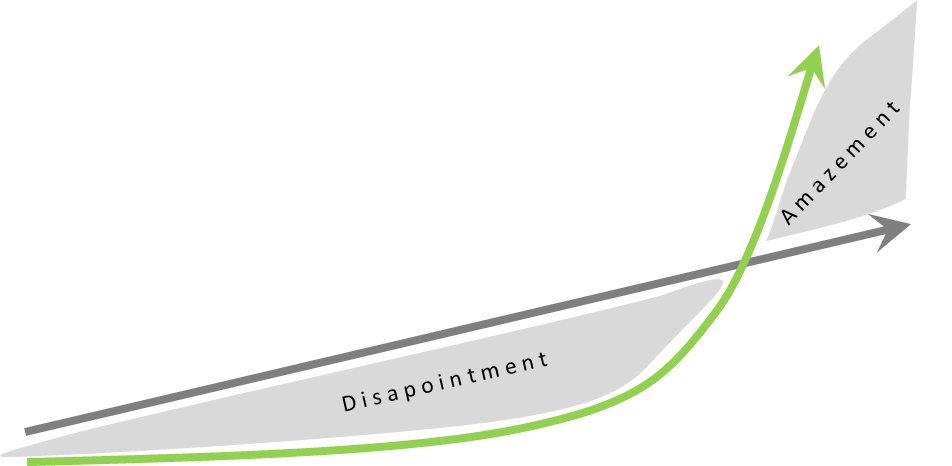
The initial gap between the expected linear growth model and the exponential one is so untenable that I would have swapped the word “Disappointment” for “Depression”.
The good news is:
- You are not alone. Among others, Twitter spent 5 years operating in a total vacuum!
- The solution is very familiar. It’s called Marketing…
… But because marketing is a catch-all term, we’ll not stop there… we will:
- Define marketing. Nothing new but we need to sync our language.
- Remind the limitations of outbound marketing.
- Quote some wisdom from HBR.
- Understand the link between the elected growth strategy and the personality of the founder.
- Propose a rule of thumb model on where to focus your scarce energy, time and bucks.
OK, quick question. What is Marketing for you?
A process by which…
- You publicize your product/service to the world.
- You understand your customers’ needs to make the best possible product to solve their problems.
Clearly, it is both but I wanted to tune in our language before moving forward. So easy part done, now let’s understand…
… the problem with outbound marketing
Consider the below-simplified version of the sales funnel.
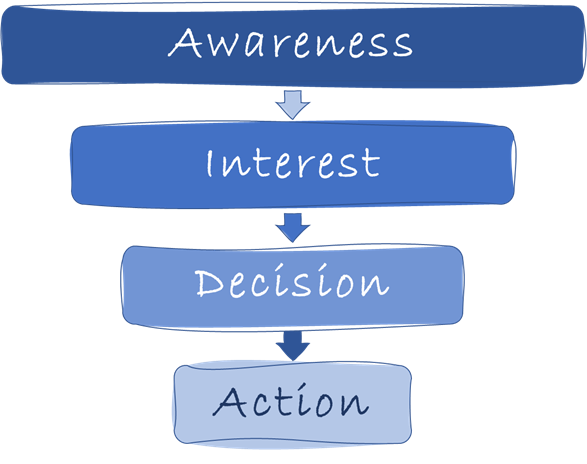
It looks like a funnel to reflect a simple idea. From one step to another the number of prospects that you keep in the loop shrinks. If we apply a 50% success rate, starting from 100 prospects at awareness stage, you end-up with 12 customers taking action. If the percentage moves to 10%, you’ll be left with 0.1 buyers only…
Although, today’s technology allows paying solely when the customer acts, i.e. buys your product. Yet you are still limited:
- It’s a linear model: No investment, no growth. It means your growth is limited by your immediate ability to invest in communication. For most of us, cash is not an infinite resource. 🙂
- Your sale’s message is direct and aims at making the prospect buy using triggers. Simon Sinek, in his now-famous book Start With Why, refers to these triggers as manipulations. A frequent example is time-bound offers. The problem with these manipulations is, because you use the wrong triggers, you increase the odds of recruiting the wrong customer. You may say who cares as long as they pay… We’ll get back to that point later.
- Targeting is a real challenge: obviously, the more you know your target user, the better you can target your audience. But there is a limit to that. To grasp that limit, we have to keep in mind that targeting is both excluding non-core customers and including core ones. As in everything else in life, the unknown unknowns are the toughest to spot. In this case, if you include the wrong target customers you will eventually end-up spotting it, but… If you miss an untapped relevant market segment you may spend a lifetime not noticing. The question becomes, “How do you tap into unidentified users?” or following the same logic “What about a product that is new to the market?”.
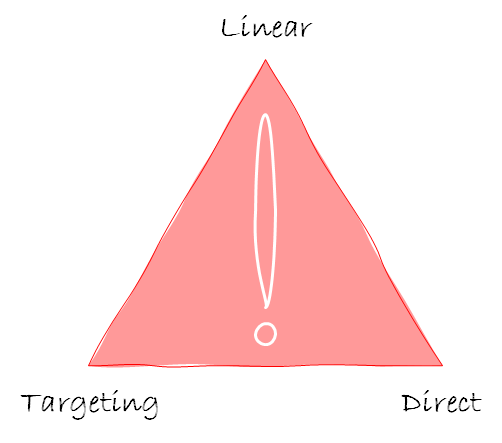
What other marketing alternatives exist?
There are numerous marketing communication strategies that describe either HOW your product will get awareness (e.g. outbound vs. inbound) or WHAT kind of awareness it’ll get (e.g. cause marketing vs. relationship marketing). For reference, the following article talks about 8 possible strategies you may adopt. In our case, we will focus only on HOW we will get awareness through the below diagram:
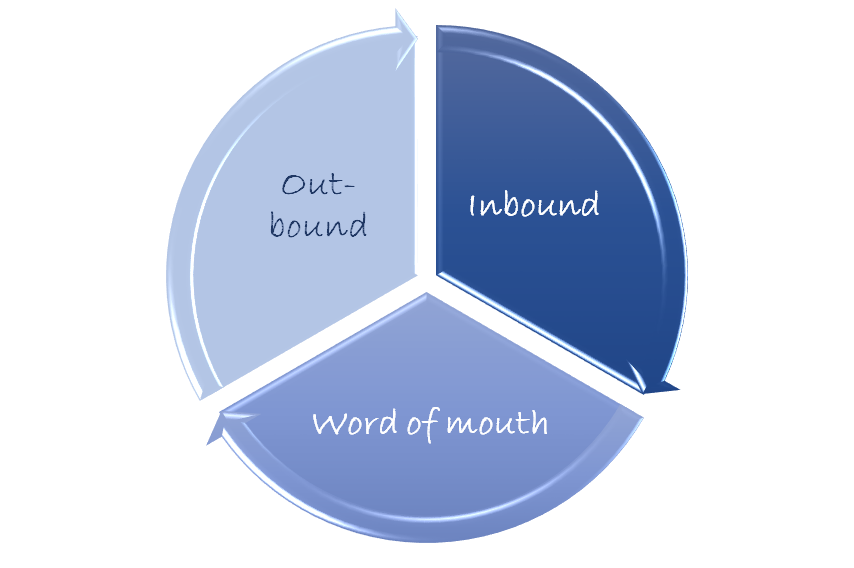
So if outbound has limitations, it can be complemented (or replaced) by inbound and WoM (Word of Mouth).
Q: If inbound is driven by quality content, what is WoM driven by?
A: The product!!!
This is exactly what companies like Tesla, Whatsup, and Haash (customer support made scalable) have relied on at the inception phase. It has worked out pretty well for them. But there is a condition… They’ve made damn good products!
OK, so thus far, we agree on:
- The meaning of marketing.
- The limitations of Outbound marketing.
- The fact that other alternatives exist.
Let’s park all that stuff and review some wisdom from HBR.
What matters most in business?
In 2003, Fred Reichheld and his team spent some time trying to understand what’s the one measure you need to track to ensure your business is healthy long term. They’ve come up with something you’ve probably already heard of: NPS — Net Promoter Score.
Your company’s effort should be directed towards making that measure play for you and not against. For that, two levers are available:
- Make the best possible product.
- Recruit the most suited customers. Indeed recruiting the wrong customers can dwindle satisfaction and hence negatively impact both NPS & WoM.
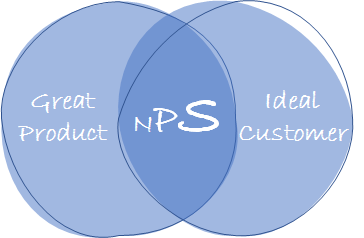
1. Focus on making the best possible product
As the web matures, this step becomes harder and harder even at the MVP (Minimum Viable Product) stage. Why?
Because the competitive landscape evolved heavily:
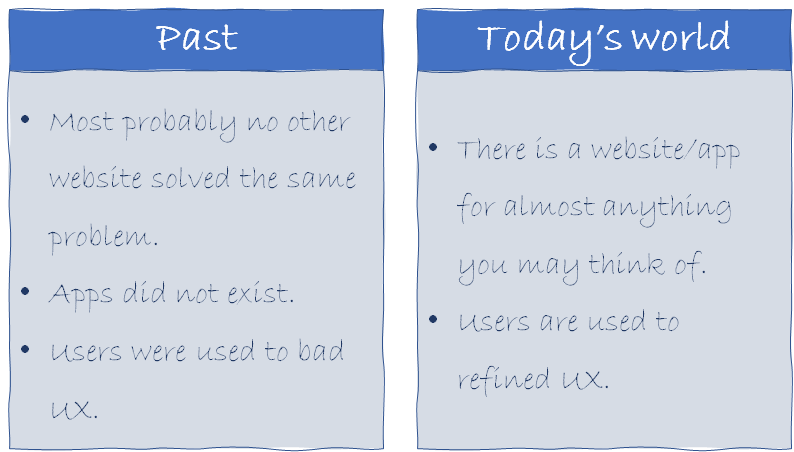
Not only are you in competition with an increased number of websites proposing “similar” solutions, but you are also in competition with the whole world when talking UX. Every morning when the sun rises, the UX challenge becomes tougher.
If you want people to switch to your product, it needs to be 10x better than whatever else exists on the market. Be it a full-fledged product or a band-aid system cobbled together in a garage. Good luck! 🙂
The pressure on the initial MVP is peaking. Even an MVP should be 10x better than an existing product. Adversely, it’s not what would intuitively expect. Moreover, one may argue that an MVP that is 10x better is not an MVP. Well, it still is in terms of the number of features offered but not in terms of UX. As Jason Fried puts it:
It’s better to launch half a product than a half-assed product.
That’s a central point to grasp so I’m going to repeat it.
Even an MVP should be 10x better than an existing product… One may argue that an MVP that is 10x better is not an MVP. Well, it still is in terms of the number of features offered but not in terms of UX.
What’s the indivisible specific added value your product is supposed to deliver. Do exactly that, nothing more, but do it 10x better than anybody else. Don’t overdo competition, underdo it. But make your minimal version top notch.
If you are unable to deliver a great UX, this puts more pressure on the value that your product needs to deliver and vice versa. See how you can adjust to your own realities but keep in mind the latter compensation rule.
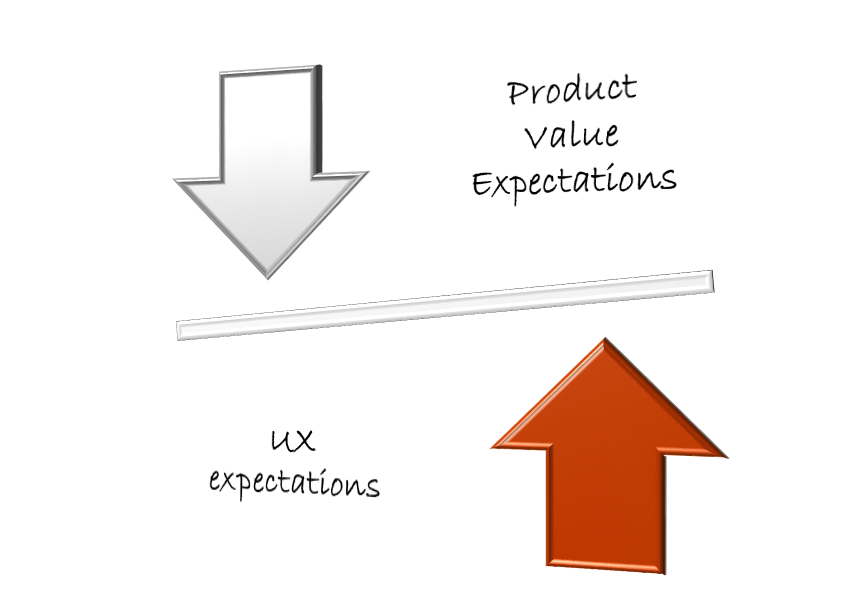
As you start iterating on your product, do keep in mind that each new feature needs to follow the same logic. Being the best at what it does, even if what it does is super specific!!!
2. Recruit the most suited customers
We’ve seen earlier how outbound marketing can be costly and make you recruit the wrong customers. Focusing on making a product that wow’s your users can help you do the opposite. “Product based Marketing” is:
- Indirect: in its pristine version, there are no manipulation tactics involved (remember that limited offer?). The direct consequence is that prospects buy out of “pure” conviction. Yes, it’s harder, it takes ages but is far more sustainable. As a consequence, leads are better qualified.
- A model that puts more emphasis on WoM (Word of Mouth). There are two major positive consequences:
1. It is exponential. You don’t need to invest in every single new lead. The more customers you have, the more customers you have… 🙂
2. It spans beyond your current group of users. Satisfied customers talk about your product in every aspect of their lives: co-workers, colleagues, friends, family… This gives you opportunities to get exposed to new audiences you would have never expected or never reached through a targeted outbound campaign.
What strategy should you go for?
Well, most tend to think that we use the most suited marketing strategy for each business context. This is a partially true statement and hence… also partially wrong.
Business context is only one input, there is a second critical input we tend to dismiss. It is the personality of the founder/boss… or even at times, the personality of someone who isn’t even part of the team… the investor!
Depending on who you are, you will be naturally drawn towards a line of conduct. The below matrix tries to summarize this weird idea:
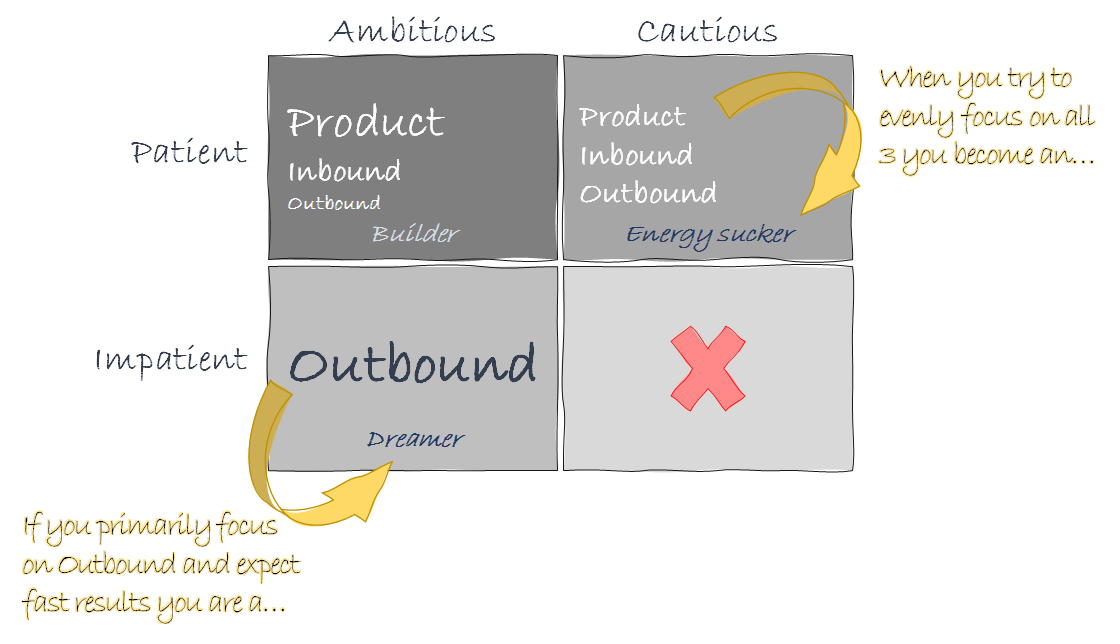
My personal pick
Let’s make a simple rule of thumb to guide investments is the following:
As long as your NPS is not in line with the market average and/or your competition, every resource should go to the product.
Any communication investment should have the sole objective of recruiting a new cohort of users for test needs but avoid any massive recruitment aimed at growth through pay advertising.
Once, you are above that threshold, your primary focus should still be improving the product and you can put some money and time into outbound Marketing.
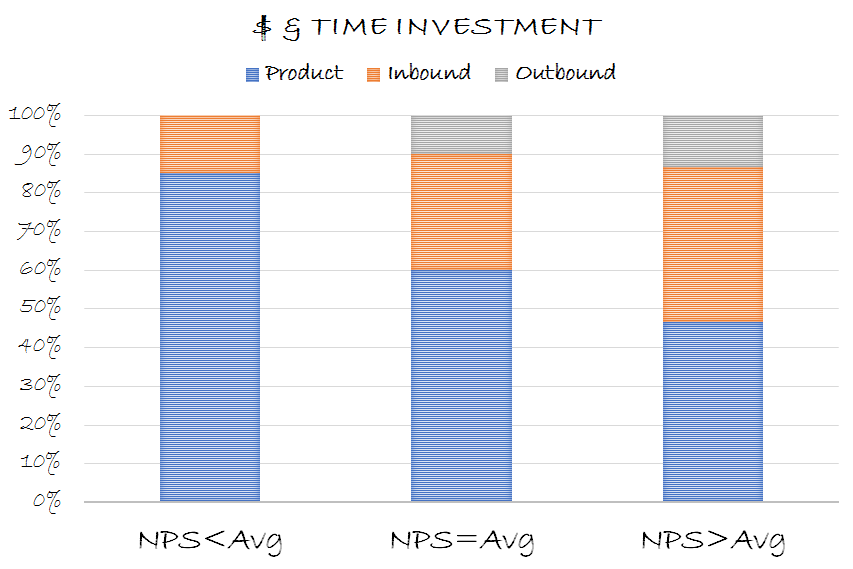
The proportions in the above chart are not exact numbers but clarify the mindset.
- Put more into your product than in communication. It is important to continue investing in your product no matter how extraordinary it is. Product development success isn’t guaranteed nor does it happen overnight. Just like you, as an outsider, have outsmarted established players, somebody you don’t know is coming at you as we speak… You have to constantly be a step ahead!
- Make word of mouth (as measured by NPS) your number 1 source of new customers. It’s free, exponential and (almost) guarantees you recruit the right customers.
- Make inbound your number 2 source. And remember, because inbound is a slow burner, you cannot expect immediate results. So keep the momentum.
- Outbound can be an accelerator under the following conditions: right NPS score, on known target audiences, no manipulation tactics involved, and at a cost lower than the lifetime revenue of a customer. Quite tough conditions 🙂
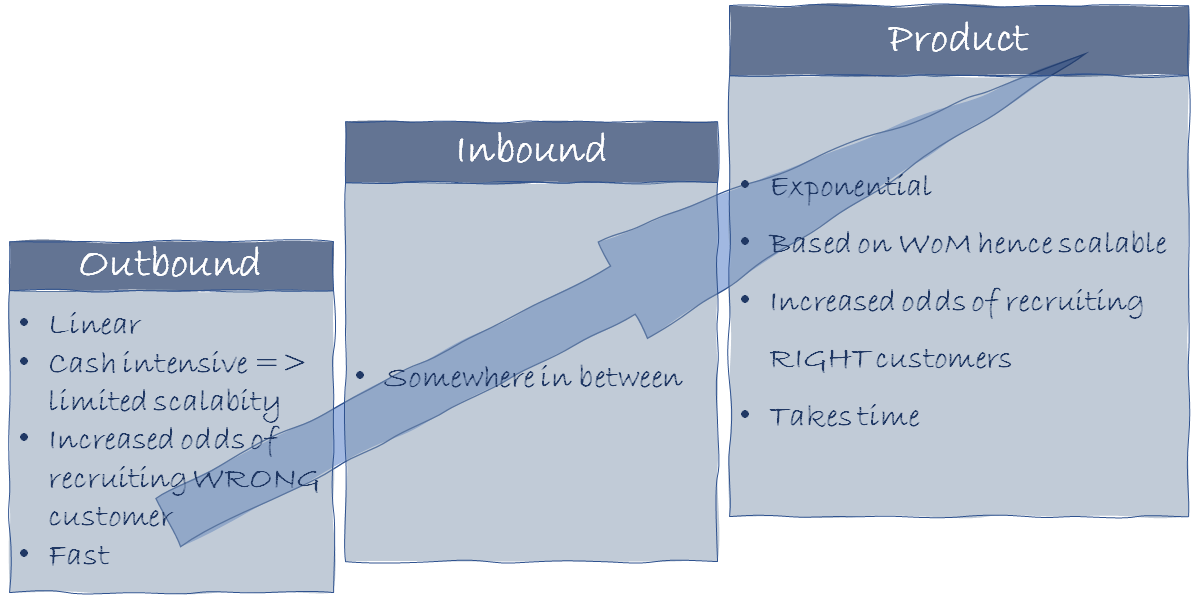
Last question
With that fresh perspective in your mind of things you (most) probably already knew, what strategy do you choose? 🙂
PS: Please answer in the comment section! 👍
Related readings
- Y-Combinator Secrets to Building Billion Dollar Products
- Iteration — How to accelerate the Feedback Loop
If interested in learning how to work with your nature and not against it, check out my book at WorkWithYourNature.com
